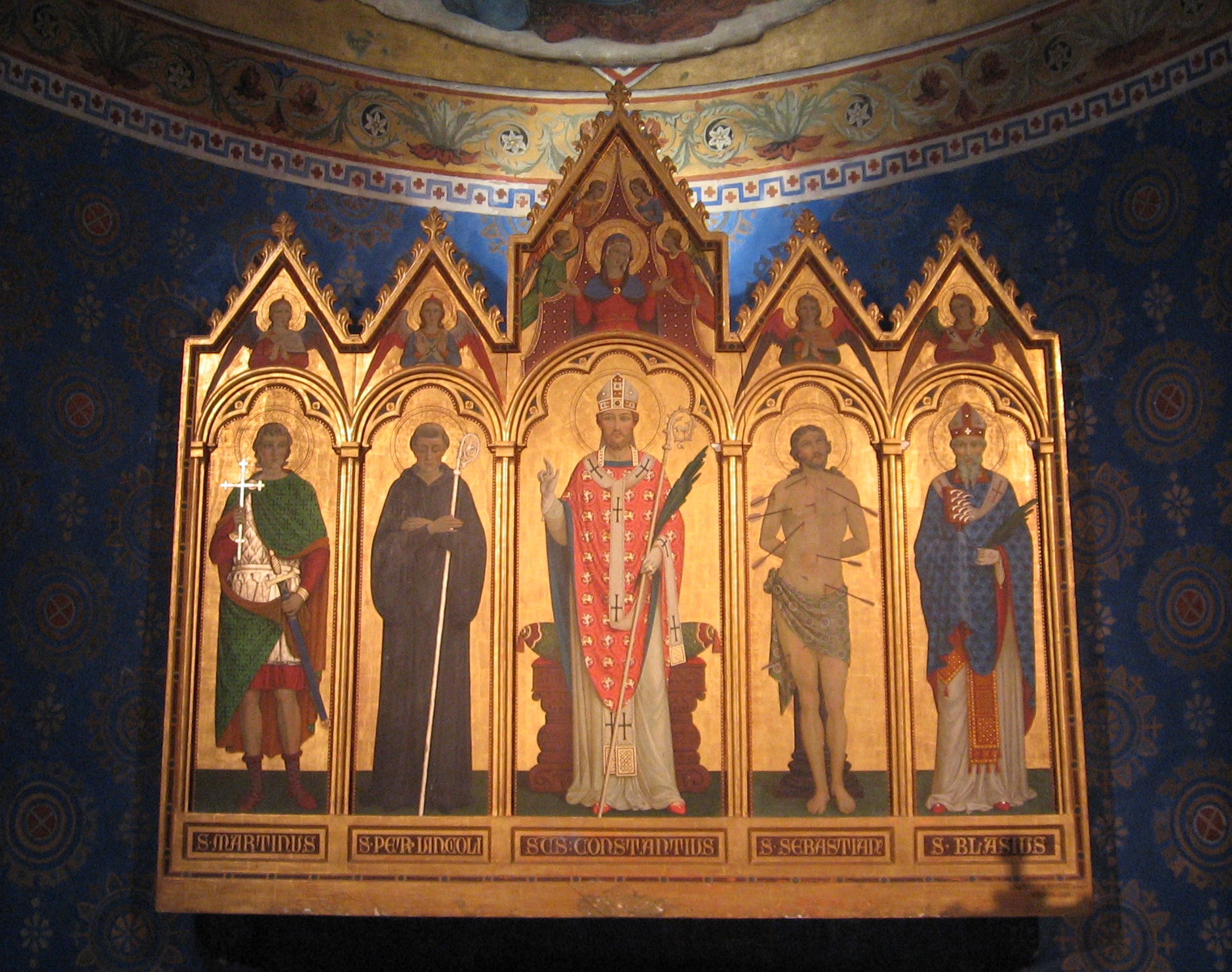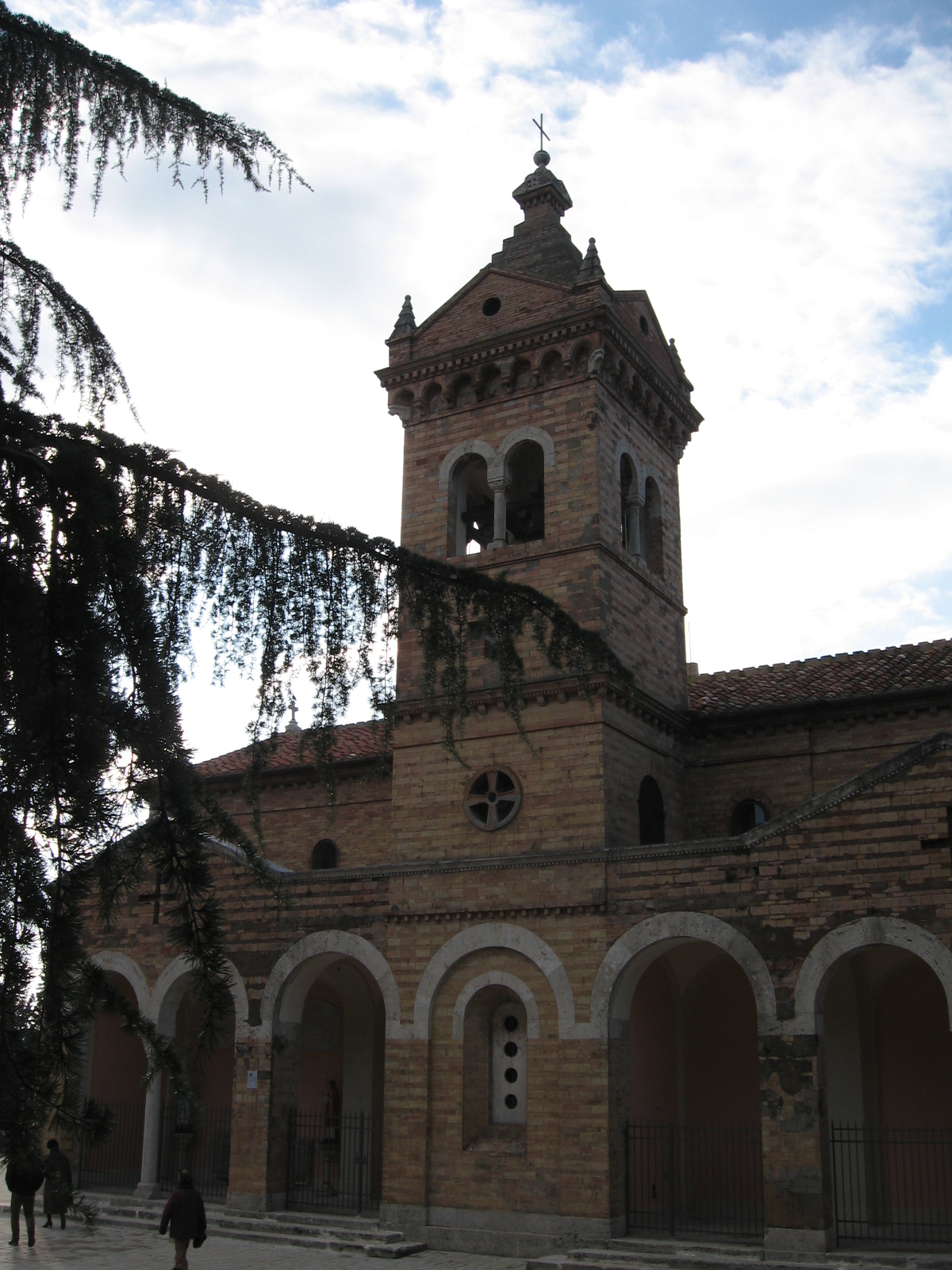Pietro Perugino (1448–1523). La
Vierge Marie et l’Enfant Jésus avec Saint Louis de Toulouse, Saint Laurent,
Saint Herculanus de Brescia, et Saint Constance de Perugia,
Saint Constance
Évêque de Pérouse en Italie (+ 180)
Martyrologe romain
SOURCE : https://nominis.cef.fr/contenus/saint/5392/Saint-Constance.html
Pietro Perugino, Polittico di
San Pietro (part. San Costanzo), 1496 - 1500, olio su tavola;
Perugia, Abbazia di San Pietro
SOURCE : https://web.archive.org/web/20161221031429/http://www.saintpatrickdc.org/ss/0129.shtml#cons
Book of
Saints – Constantine and Others
Article
CONSTANTINE and OTHERS (Saints) Martyrs (January 29)
(2nd century) Saint Constantine, first Bishop of Perugia in Central Italy,
together with numerous Christians of his flock, is stated to have been put to
death on account of his religion under the Emperor Marcus Aurelius, about A.D.
178. The detailed Acts of the Saint, accessible at Perugia, are unfortunately
far from reliable.
MLA Citation
Monks of Ramsgate. “Constantine and Others”. Book of Saints, 1921. CatholicSaints.Info. 13
October 2012.
Web. 29 January 2021.
<http://catholicsaints.info/book-of-saints-constantine-and-others/>
SOURCE : https://catholicsaints.info/book-of-saints-constantine-and-others/
Chiesa di San Costanzo a Perugia - Facciata
St Constantius
(29th January)
Perugia: Home History Art Saints Walks Monuments Museums
St Constantius is listed under the same date in
the Hieronymian Martyrology and
Perugia is given as his place of execution.
The four known versions of the legend of St
Constantius are designated BHL 1937-40. (A copy of BHL 1937 is preserved
under 29th January in the Leggendari del Duomo).
These record the martyrdom under the Emperor Antoninus. He suffered
torture under officials named Lucius and Carsilius, and then took refuge in the
house of a certain Anastasius “ad locum qui dicitur Monticellus” (at the place
called Monticellus), but both were subsequently arrested, together with their
colleague Carpophorus. They managed to convert their oppressors, and were
released. However, other officials questioned St Constantius as he
travelled along the Via Salaria, and he was arrested when he admitted that he
was trying to visit the Spoletan SS Concordius and Pontian. He was
imprisoned in Assisi and then executed “in trivio Fulgineato, non longe a
civitate ipsa” (at the crossroads, not far from Foligno). An angel appeared
to a perugian noble called Levianus, instructing him to find the body and to
bury it with honour. He duly found it and took it for burial at a
place “Areola”, which presumably refers to the location of the present
church of San Costanzo, Perugia.
St Constantius, who is said to have been the first
bishop of Perugia, was adopted as a patron saint of the city in 1310 (probably
after lobbying by the friars of San Domenico).
His relics were apparently re-discovered in the church
of San Costanzo in 1781 and translated to a new altar there in 1825.
Cult of St Constantius outside Perugia
A church (12th century) outside Porta del Cieco, Trevi
(see the Walk around Trevi), which stood on the presumed
site of the martyrdom, was demolished in 1890. Virginia Ryan, the author
of "Where the Cypress Rises",
writes about her discovery of what seem to be the remains of this church in her
garden there.
The canons of the Duomo of Orvieto also had their own
church of San Costanzo (dedicated to St Constantius), the foundations of
which were discovered under the nave of the present Duomo in 1955-6.
Read more:
E. Paoli, “Agiografia e Culto dei Santi a Perugia fra
Alto e Basso Medioevo”, in
A. Bartoli Langeli and E Menestò (Eds), “La Chiesa di
Perugia nel Primo Millennio: Atti del Convegno di Studi (Perugia, 1-3 April
2004)”, Spoleto (2005) pp. 41-84
Section 4 on St Constantius begins on page 55.
SOURCE : http://www.keytoumbria.com/Perugia/St_Constantius.html
Saint Constantius of Perugia
Also
known as
- Costanzo
of Perugia
Profile
First bishop of Perugia, Italy at age 30. He evangelized his people, cared for
the poor, and lived a simple life that shamed the ruling
classes. Imprisoned, tortured and martyred with many of his flock in the
persecution of Marcus Aurelius.
- beheaded in 170
- relics in an altar in the church of San Constanzo in 1205
- relics re-enshrined in 1781
- relics re-enshrined in 1825 at a new altar in the present church of San Constanzo
- Perugia-Città della Pieve, Italy, archdiocese of
- Perugia, Italy,
city of
Additional Information
- Book of Saints, by the Monks of Ramsgate
- books
- Our Sunday Visitor’s
Encyclopedia of Saints
- Sacred and Legendary Art, by Anna Jameson
- other
sites in english
- sitios
en español
- Martirologio Romano, 2001 edición
- fonti
in italiano
- spletne
strani v slovenšcini
MLA Citation
- “Saint Constantius of
Perugia“. CatholicSaints.Info. 27 December 2020. Web. 29
January 2021.
<https://catholicsaints.info/saint-constantius-of-perugia/>
SOURCE : https://catholicsaints.info/saint-constantius-of-perugia/
Saint Constantius
29-01-2021
Saint Constantius, revered as the first bishop of
Perugia, was martyred in the 2nd century, either under Marcus Aurelius (in
office from 161 to 180) or during the persecutions of his predecessor Antoninus
Pius.
Saint Constantius, revered as the first bishop of Perugia, was martyred in the 2nd century, either under Marcus Aurelius (in office from 161 to 180) or during the persecutions of his predecessor Antoninus Pius. Over time, more hagiographies have emerged, which outline Constantius as a man of great faith and generous spirit, who was elected bishop when he was still young.
According to tradition, some soldiers took Constantius before the consul Lucius, they scourged him and immersed him in boiling water, from which he emerged unharmed. He was therefore imprisoned, but managed to convert his jailers, who helped him flee; he found refuge in the home of a Christian named Anastasius, who was later arrested with him. After various vicissitudes, Constantius was taken to Foligno and beheaded at a place called "il Trivio".
Shortly after his martyrdom, his body was taken to
Perugia and buried in an area outside Porta San Pietro, the site of the
first city cathedral, where around 178 a mausoleum was erected in honour of
Saint Constantius. The present-day San Costanzo church was consecrated on the
same site in 1205, and the Saint's relics are still housed there.
SOURCE : https://newdailycompass.com/en/saint-constantius-1
Chiesa di San Costanzo a Perugia - Interno
San Costanzo di Perugia Vescovo e martire
Nato a Foligno, è stato il primo vescovo di Perugia.
Martirizzato al tempo delle persecuzioni dell'imperatore Marco Aurelio. Secondo
la tradizione fu condotto da alcuni soldati davanti al console Lucio e
barbaramente flagellato, quindi immerso nell'acqua bollente, da dove uscì
miracolosamente illeso. Ricondotto in carcere, convertì i suoi custodi che lo
aiutarono a fuggire. Rifugiatosi a casa del cristiano Anastasio, fu con questo
di nuovo arrestato e decapitato nella città di Foligno, intorno all'anno 170.
Il corpo del santo, dopo il martirio, fu portato a
Perugia e sepolto non lontano dalla città in un luogo detto Areola fuori Porta
S.Pietro, dove venne costruita la prima cattedrale di Perugia.
Etimologia: Costanzo = che ha fermezza, tenace,
dal latino
Emblema: Bastone pastorale, Palma
Martirologio Romano: A Perugia, san Costanzo,
vescovo.
E' ricordato al 29 gennaio già dal Martirologio Geronimiano. Secondo la leggenda, di cui esistono quattro redazioni, fu tradotto davanti al console Lucio durante la persecuzione di Antonino e barbaramente flagellato, indi rinchiuso con altri compagni in una stufa ardente dalla quale uscì illeso. Ricondotto in carcere, convertì i suoi custodi che lo aiutarono a fuggire. Rifugiatosi in casa di un certo Anastasio cristiano, fu, insieme con questi, di nuovo arrestato. Dopo varie peripezie nelle carceri di Assisi e Spello, fu decapitato presso Foligno. Le diverse redazioni della passio sono concordi nello assegnare il suo martirio al tempo di Antonino in una località presso Foligno denominata "il Trivio". Il santo perugino aveva infatti in questa città, vicino a Porta Romana, una chiesa che, secondo lo Iacobilli, fu demolita nel 1527. Questi afferma inoltre che, al suo tempo, tale località era chiamata ancora "campagna di S. Costanzo".
Parimenti tutte le redazioni della passio affermano che il santo, dopo il martirio, fu portato a Perugia e sepolto non lontano dalla città in, un luogo detto "Areola fuori Porta S. Pietro", ove sorse la prima cattedrale di Perugia, dedicata al principe degli Apostoli. In questo medesimo luogo fu eretta l'attuale chiesa di S. Costanzo consacrata, secondo un'iscrizione esistente nell'antico altare, nel 1205 dal vescovo di Perugia Viviano.
L'episcopato di Costanzo, secondo il Lanzoni ed il Delehaye, riposa su una tradizione antica e seria per cui si può ritenere assai probabile che egli sia stato il primo vescovo di Perugia. Il suo martirio risale alle persecuzioni dei primi secoli.
I perugini venerano in lui uno dei protettori della
città. Il suo culto si diffuse anche fuori dell'Umbria. Nel 1781 fu fatta una
ricognizione delle sue reliquie e nel 1825, con grande solennità, la
traslazione delle medesime dal vecchio al nuovo altare, sempre nella attuale
chiesa di S. Costanzo.
Autore: Aldo Brunacci
SOURCE : http://www.santiebeati.it/dettaglio/39050
Voir aussi : http://www.perugiaonline.it/perugia_san_costanzo_perugia.html
https://www.letorridibagnara.it/saint-constantius-of-perugia/
https://www.ilturista.info/blog/12680-La_Luminaria_di_San_Costanzo_a_Perugia/
https://www.perugiatoday.it/video/perugia-torcolo-san-costanzo-ricetta-pasticceria-2000.html






